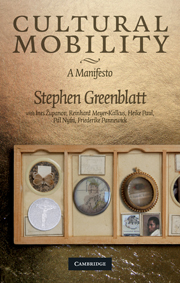Book contents
- Frontmatter
- Contents
- List of authors
- List of illustrations
- Acknowledgments
- 1 Cultural mobility: an introduction
- 2 “The Wheel of Torments”: mobility and redemption in Portuguese colonial India (sixteenth century)
- 3 Theatrical mobility
- 4 World literature beyond Goethe
- 5 Cultural mobility between Boston and Berlin: how Germans have read and reread narratives of American slavery
- 6 Struggling for mobility: migration, tourism, and cultural authority in contemporary China
- 7 Performativity and mobility: Middle Eastern traditions on the move
- 8 A mobility studies manifesto
- Index
8 - A mobility studies manifesto
Published online by Cambridge University Press: 05 June 2012
- Frontmatter
- Contents
- List of authors
- List of illustrations
- Acknowledgments
- 1 Cultural mobility: an introduction
- 2 “The Wheel of Torments”: mobility and redemption in Portuguese colonial India (sixteenth century)
- 3 Theatrical mobility
- 4 World literature beyond Goethe
- 5 Cultural mobility between Boston and Berlin: how Germans have read and reread narratives of American slavery
- 6 Struggling for mobility: migration, tourism, and cultural authority in contemporary China
- 7 Performativity and mobility: Middle Eastern traditions on the move
- 8 A mobility studies manifesto
- Index
Summary
First, mobility must be taken in a highly literal sense. Boarding a plane, venturing on a ship, climbing onto the back of a wagon, crowding into a coach, mounting on horseback, or simply setting one foot in front of the other and walking: these are indispensable keys to understanding the fate of cultures. The physical, infrastructural, and institutional conditions of movement – the available routes; the maps; the vehicles; the relative speed; the controls and costs; the limits on what can be transported; the authorizations required; the inns, relay stations and transfer points; the travel facilitators – are all serious objects of analysis. Only when conditions directly related to literal movement are firmly grasped will it be possible fully to understand the metaphorical movements: between center and periphery; faith and skepticism; order and chaos; exteriority and interiority. Almost every one of these metaphorical movements will be understood, on analysis, to involve some kinds of physical movement as well.
Second, mobility studies should shed light on hidden as well as conspicuous movements of peoples, objects, images, texts, and ideas. Here again it would be well to begin with the literal sense: moments in which cultural goods are transferred out of sight, concealed inside cunningly designed shells of the familiar or disguised by subtle adjustments of color and form. From here it is possible to move to more metaphorical notions of hiddenness: unconscious, unrecognized, or deliberately distorted mobility, often in response to regimes of censorship or repression.
- Type
- Chapter
- Information
- Cultural MobilityA Manifesto, pp. 250 - 253Publisher: Cambridge University PressPrint publication year: 2009
- 11
- Cited by



